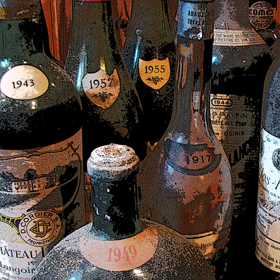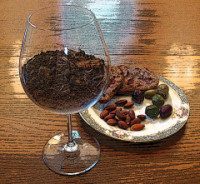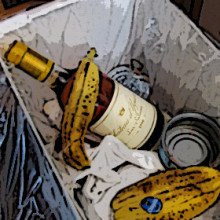Visual Wine Inspection; Looking For Clarity, Color & Intensity.
Chapter Three, Part Five.
 When analyzing wine a vigilant visual inspection will give you some clues as to the condition, age and style of the wine. Visual indicators may also offer you the first tip-off that the wine is flawed. For example, bad wine is often cloudy, off-color, or has a cute animal on the label.
When analyzing wine a vigilant visual inspection will give you some clues as to the condition, age and style of the wine. Visual indicators may also offer you the first tip-off that the wine is flawed. For example, bad wine is often cloudy, off-color, or has a cute animal on the label.
Begin your visual examination by checking the wine for clarity. Wine can become cloudy if bacterium gets inside the bottle, but before you turn that murky bottle into a grab bag gift at the office Christmas party you should know there is another cause for cloudiness that is not considered a flaw.
As wine ages it may develop sediment deposits as tiny particles of tannin and color pigment fall to the bottom of the bottle. This is not a sign of a flawed or poor quality wine. Sediment is usually found in better wines like Napa Valley Cabernets and old classified Bordeaux. Most of the red wine I drink contains sediment which might explain why I’m now sporting large sediment deposits of my own just north of my waistline.
 Sediment can result in cloudy wine if the bottle has been shaken. If you haven’t opened the bottle, stand it upright and leave it undisturbed for a few days so that the particles can settle to the bottom of the bottle. You can then slowly pour the wine into a decanter or pitcher leaving the sediment behind.
Sediment can result in cloudy wine if the bottle has been shaken. If you haven’t opened the bottle, stand it upright and leave it undisturbed for a few days so that the particles can settle to the bottom of the bottle. You can then slowly pour the wine into a decanter or pitcher leaving the sediment behind.
Years ago, before winemakers began filtering and fining their wines to spotless perfection, decanting wine was a common procedure. It may become necessary once again as it’s becoming more common to find sediment in today’s wine. Winemaking appears to have come full circle as many winemakers now refrain from fining and filtering because they feel these practices can strip wine of its quality (for more clarification see Chapter 12).
Next, take a gander at the intensity of the wines color. This can sometimes reveal what to expect regarding the weight of the wine. A wine that is lighter in color or somewhat transparent will probably have less weight than a wine that is darker or more opaque. Pinot Grigio for example, is pale in color and also light in body. Barrel fermented Chardonnay on the other hand, is considerably darker and possesses much more body. Likewise, Pinot Noir is noticeably lighter in color and more transparent than Cabernet Sauvignon, which indicates that the Pinot Noir is lighter in weight. Color doesn’t actually affect the weight of wine, this is simply one of those indicators I’ve come to trust.
As wine ages, its color intensity fades which allows you to make certain assumptions about the wine. Some heavy-duty reds take decades to shed their opaque veil, but for the most part you can assume a dark, intensely colored red wine is still young.
 Before time works its magic on wine and integrates its various components into a mellow, ready to drink beverage, young wines can seem a little punchy. Drinking these angular adolescents is like letting an angry boxer loose in your mouth.
Before time works its magic on wine and integrates its various components into a mellow, ready to drink beverage, young wines can seem a little punchy. Drinking these angular adolescents is like letting an angry boxer loose in your mouth.
As you swish around a mouthful of young wine, BAM! Acidity sends a searing left jab into your cheeks. OOF! Tannins fire a scathing uppercut to your gums. With time these individual elements mellow into a cohesive whole and the wine becomes a lot less jarring.
If you open a bottle of wine and discover it’s still in this awkward youthful state you can re-cork the bottle and try it the following day. If that’s not an option you can try to soften it through decanting or aerating. Often there’s little choice but to suffer through an aggressive young wine and hope you don’t end up punch-drunk.
By now you’ve been looking at your wine for about five minutes and you’re probably getting thirsty. Plus the other people in the restaurant are starting to wonder what’s wrong with you. But before you take a sip you want to examine the wine’s color. Because some wines can be opaque, look to the rim to make out the color. The rim is where the edge of the wine meets the glass and allows for keener inspection. Keep in mind that white wines grow darker with time, red wines grow lighter as they mature, and with each passing day I only grow shorter and fatter.
The highlights or reflections in young red wines appear bluish or faintly purple. As red wine ages the color may pass through one or more stages of black, deep purple, maroon, red, crimson, ruby, garnet, oxblood, brick, rusty-orange and eventually brown.
In a young white wine the highlights will appear greenish or pale yellow. At various stages of its evolution, white wine may appear almost watery, pale green, pale yellow, straw, golden, orange, bronze and finally brown. There comes a time in the evolution of red and white wines when you can’t tell which is which. When you’re appraising an old wine that looks more brown than red or white, the highlights found in the rim will indicate what color wine you’re holding.
If white wine appears too dark it could have a number of things wrong with it. A leaky cork may have exposed the wine to air causing it to oxidize prematurely. It might have been stored incorrectly, having been subjected to excessive heat and light. As its biological clock ticks, white wine gets progressively darker so it could simply be over the hill. But before you dump it down the drain be certain it’s not a dessert wine.
 Sweet dessert wines like those from the Sauternes region of Bordeaux can age for decades, growing progressively darker with each passing year. I’ve been told many heartbreaking tales of bronze-hued bottles of Chateau d’Yquem being poured down the drain because someone assumed a dark white wine couldn’t possibly be any good. There’s a special place in wine-hell for those people.
Sweet dessert wines like those from the Sauternes region of Bordeaux can age for decades, growing progressively darker with each passing year. I’ve been told many heartbreaking tales of bronze-hued bottles of Chateau d’Yquem being poured down the drain because someone assumed a dark white wine couldn’t possibly be any good. There’s a special place in wine-hell for those people.
It’s a common misconception that white wine doesn’t age well. The great white Burgundies and German Rieslings, among others, can age and improve for years. Sweet white wines like Chateau d’Yquem have the potential to age for decades, providing some unwitting soul doesn’t turn them into expensive French Draineau.
These visual clues will help you determine the condition of your wine before you taste it. Upon cleaning out her dearly departed husband’s wine cellar a little old lady from Hackensack once gave me several bottles of 50 year old Grand Cru red Burgundy. These Burgundies were so pale that they were actually lighter in color than the old white wines in her cellar. Visual inspection was all that was required to determine that they were undrinkable. Call me a wine snob if you must, but I refuse to drink any wine the color of my grandfather’s liver spots.




















